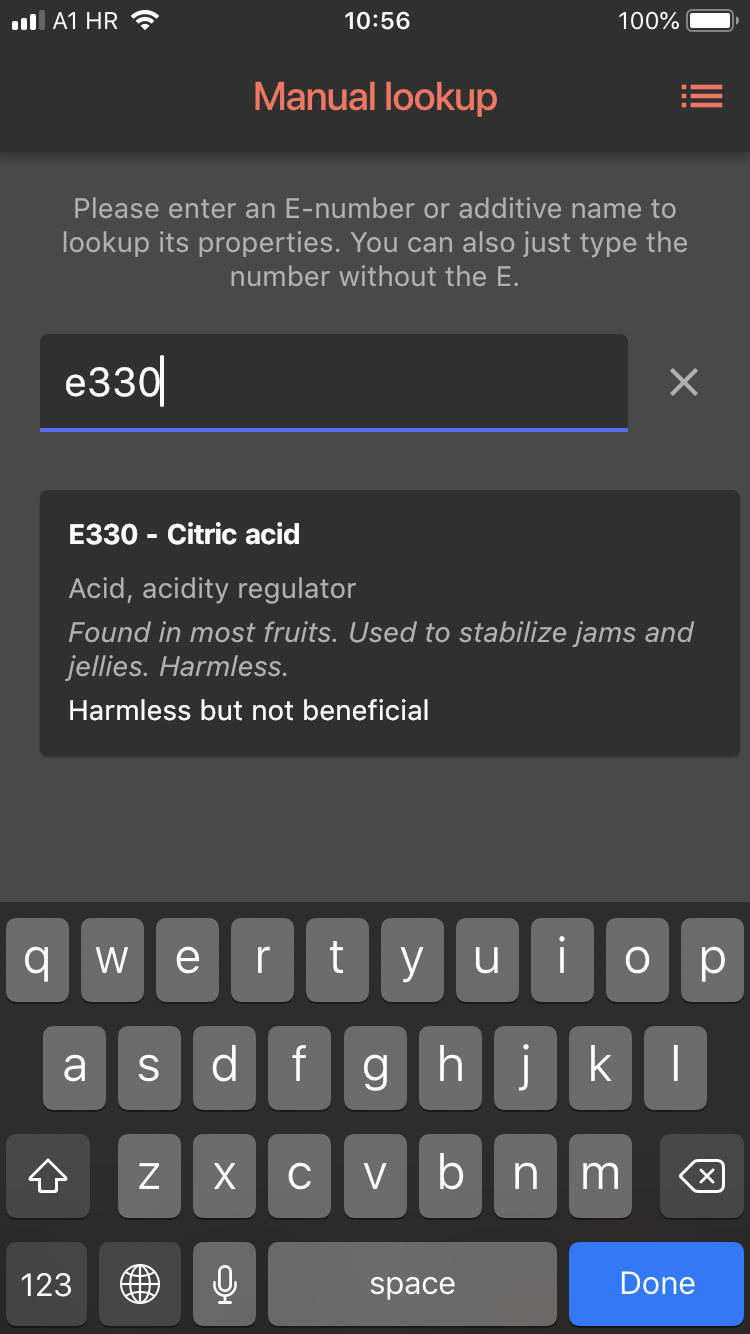My son Mihael finally made a proper web page for his latest software project, the one he won the 3rd place in the national competition with. What’s actually more impressive is that the competition is for all four high school years, which means he competed against the 3rd and 4th year students, as the only 1st year student in the competition, and most of the projects were done by whole teams while he did this one himself.

He put it up on both Apple and Android stores, but making a paid version on the Android store was too complicated for some reason that I already forgot because it was months ago, so that one is free. The iOS version costs some money and is well worth it if you ask me, because I use it whenever I have to buy something that contains tiny e-codes on the label and I want to find out what kind of shit I’m about to eat. So yeah, buy it so that you don’t end up eating poison, and Mihael learns that writing software beats making YouTube videos about playing video games as a career path. 🙂

Playing video games on Youtube has a low barrier to entry, so any fool can do it. Being good at it means you have to be an entertainer, and you really don’t want to measure your success by how well you’ve clown-danced for people.
You can charge more money for the stuff that’s hard to do, ’cause you’ll be among the rare people who can do it.
All true; also, people tend to do things that are fun to do, and avoid difficult and boring jobs, which therefore tend to pay more. Then, when you get the money, you can do fun things all you want. 🙂
Luckily, difficult doesn’t necessarily coincide with boring. It’s the shitty low-entry jobs that are the most boring and soul-sucking. Granted, sometimes they’re the only way to start anything. There’s a lot of grind involved in becoming successful at something.
Mihael’s problem is that he’s constantly under attack by all the kids who feel threatened by him, and he doesn’t respond well to that, making it worse by retaliating too hard and too quickly. It obviously gets better with time, as I was similarly maladjusted at his age, if not more. But since he’s 15, he takes those attacks too literally and too seriously, and the worst part of that is that they managed to convince him that some of his strongest sides are actually his weakest. For instance, when he presents a project in front of an adult audience, he’s Steve Jobs good. But when he presents it in front of other kids, they intentionally attempt to deceive him, to convince him that he’s boring, that his presentation sucks, is too long, not interesting etc., and the worst part is that the teachers tend to agree with the majority of kids because that’s how they control the crowd. Essentially, I don’t think he’s getting the right kind of education in school, because neither the teachers or other students have his best interests at heart. The teachers want to have it easy and work the least possible, and other children don’t want to feel inferior. Also, the problem with school is that they teach him the opposite of what I’m trying to teach him. I try to teach him how to think aggressively, examine data, reach conclusions and act; the school perceives all of that as “challenge to authority”, and heaven forbid their authority be challenged. So basically you have a kid who is taught to ask me how something works and question my arguments as much as he wants, as long as he uses valid logic and sources, and at school he has to function in a parallel universe where often the teachers speak abject nonsense and expect to be treated as infallible gods.
Dealing with people is the most frustrating aspect of any job, especially when you’re different from the mainstream crowd in any sense. And if you go into streaming games, you have to pander to those kinds of people. Software development less so, there’s less bullshit and more actual productive work, at least on the high end.
If he wants to earn serious money, he’ll have to learn how to deal with people. That’s just how it is.
Add more photos to App Store, like on blog. Current one looks like app threw an error or something. Tutorial (read marketing) video would be great as well.
App is great, but marketing sells – could be additional lesson for Mihael 🙂
Btw, you didn’t want his name in App Store or it’s not possible for a minor to sell stuff? Which would be funny, since they have no problems with selling stuff to kids.
You wouldn’t believe the amount of American red tape one has to struggle through in order to do anything there. In order to actually *sell* on Play Store he’d basically have to have his own UK based company, and the cost of that was prohibitive.
So I keep telling him.
I am trying the app and I was shocked that I couldn’t find a single product in a fridge (I’m on vacation, but still) with E shit in it. It’s not that app is not working – I checked in “analog way” (magnifying glasses and my eyes :-)) – there really isn’t single E compound listed.
Manufacturers obviously realised people started to look for E numbers (and learned few harmful ones), so instead – they are now listing actual chemical names instead of E numbers. Dove soap and “fuzetea” drink (CocaCola brand) as two examples I found.
How many people actually now those? I don’t, thats for sure.
I think Mihael needs to up his game and start scanning for chemical compounds by names which he has in the database. And start adding translations over time.
Another cool gimmick for some future version would be scanning live, instead of scanning taken photo.
And why not add calories scan – I look for those constantly … ok, I need to start posting feature requests on his support page 🙂
Great design btw, nice, clean and simple user experience.
He actually tried to implement this feature (scanning for compound names) but it’s a nightmare, since there are many synonyms, the OCR isn’t completely reliable in field conditions (weird lighting, moving camera and subject, crumpled substrate, weird colors etc.) so l can be read as 1, O as 0 etc., and those are all corrected by algorithm in his E-code recognition, but you can’t really do it if you don’t know what you expect to see, so basically it’s possible, it’s just harder than hammering nails with your dick. He had the feature implemented between the county and state competition but I told him to turn it off as it was so unreliable it introduced all kinds of false positives and misreads.
Yea I didn’t know that until I actually tried the app and realised I got no results and I got really suspicious after I got no results for CocaCola branded drink 🙂
As for OCR, it could actually be improved with “live scanning gimmick feature” (instead of photo OCR) since you get 30 frames per second of information and you can progressively improve OCR accuracy.
Combine that with similar word matching either in SQL or in code using regular expressions against known database of compounds and you could actually get quite usable result.
Sure, this is hard stuff and presumes there is video OCR available for his development stack and is way ahead of teen kids, but Mihael already is way ahead, so this could be a challenge to prevent his app going obsolete by manufacturers tricks to avoid E numbers.
Is this all worth for school project?
I don’t know, it could be, app has great foundation – it is simple and quickly solves specific task and has a lot of room for improvements like detecting other stuff like already mentioned calories and then other nutrients (which are usually printed in bigger font, but with age gets harder and harder to read). It can further be expanded to hook up with price comparison services and so on.
Certainly has potential.
Anyway, great effort, especially when you put it in context of what other teen kids do in this age …
The kids in those competitions are so insanely ahead of what you’d expect it’s actually mind-boggling. Most projects are what you’d expect at graduate or post-graduate university level, and it’s insanely ahead of what they actually learn at school. The school literally has nothing to do with any of it, which is obvious if you compare the school IT curriculum with the tools and skill-set used for writing the projects. Not only that, but I don’t think most high school teachers are able to even understand how it’s done. For instance, Mihael is fluent in Python, Flutter and SQL, uses Linux and OS X as development platforms, and can write in C++ if pressed. I would expect most FER graduates to just shit themselves if they had to do this stuff at that level.
Those would probably work, but the app would have to be significantly reworked, for instance a different OCR API would have to be used and that would change significant parts of the workflow. Also, the database would have to be enlarged by a factor of at least five, and it took months to fill as it is.
Probably not, because he’s already developing something quite insanely complicated for the next year’s competition. 🙂 I can’t say what because I don’t want his competitors to know ahead of time. 🙂
It’s just awesome when you say “way ahead” without even realising how extremely conservative that statement is 🙂
Re: manufacturers avoiding e-codes, we found that out when we went shopping for sample foods for the demonstration. 🙂 We basically fine-combed a department store to end up with a bag of stuff that actually contains the codes, so the problem is very real. Apparently the manufacturers figured out that people look at the label and use the number of e-codes to figure out what is “artificial”. That is very deceiving, as we found candy that has five or more codes and everything’s fine, it’s citric acid, vitamin C, some natural colors, gelatin etc., and then you can have something that has only one e-code and it’s monosodium glutamate, which is probably the most toxic compound that’s still legal to put into food. Neurotoxic, accelerates cellular aging, possibly carcinogenic.